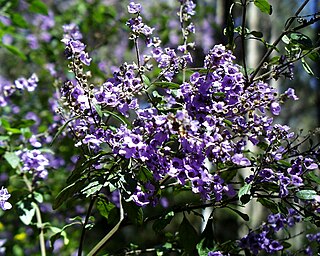
Prostanthera melissifolia, commonly known as balm mint bush, is a species of flowering plant in the family Lamiaceae and is endemic to south-eastern Australia. It is an erect shrub with hairy branches, egg-shaped leaves with fine teeth on the edges and mauve to purple or pink flowers on the ends of branchlets.
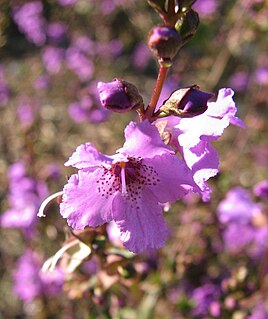
Prostanthera galbraithiae, commonly known as Wellington mint-bush, is a species of flowering plant in the family Lamiaceae and is endemic to Victoria in Australia. It is an erect or spreading shrub with densely hairy branches that are more or less square in cross-section, narrow egg-shaped or oblong leaves with the edges rolled under, and deep mauve to purple flowers with maroon dots inside the petal tube.

Prostanthera stenophylla is a species of flowering plant in the family Lamiaceae and is endemic to Wollemi National Park in New South Wales. It is an erect, slender, aromatic shrub with hairy, oblong leaves and small groups of pale bluish mauve to violet flowers.

Prostanthera denticulata, commonly known as rough mint-bush, is a species of flowering plant in the family Lamiaceae and is endemic to south-eastern continental Australia. It is a straggling to almost prostrate, aromatic shrub with narrow egg-shaped leaves and purple to mauve flowers arranged in leaf axils or on the ends of branchlets.

Prostanthera saxicola is a species of flowering plant in the family Lamiaceae and is endemic to eastern Australia. It is a shrub with linear to elliptic leaves and white to mauve flowers arranged in leaf axils.
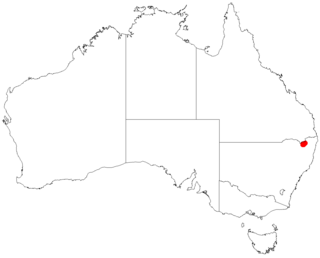
Prostanthera staurophylla, commonly known as Tenterfield mint-bush, is a species of flowering plant in the family Lamiaceae and is endemic to a small area on the New England Tableland of New South Wales. It is an erect to spreading, strongly aromatic shrub with hairy branches, deeply lobed leaves and bluish-mauve flowers with darker markings.
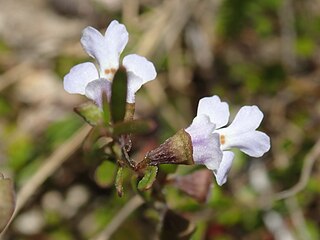
Prostanthera junonis, commonly known as Somersby mintbush, is a species of flowering plant in the family Lamiaceae and is endemic to the Central Coast of New South Wales. It is a low, straggling shrub with hairy, egg-shaped leaves and purple to mauve flowers.

Prostanthera askania, commonly known as tranquility mintbush, is a shrub that is endemic to Australia. It has mostly pale mauve flowers, strongly scented leaves and branches, dull green, toothed egg-shaped leaves and a restricted distribution.

Prostanthera canaliculata is a species of flowering plant in the family Lamiaceae and is endemic to the south-west of Western Australia. It is a small, erect shrub with hairy branchlets, narrow egg-shaped to narrow elliptical leaves and pale blue or pale violet to white flowers with no markings.

Prostanthera cineolifera, commonly known as the Singleton mint bush, is a species of flowering plant in the family Lamiaceae and is endemic to eastern New South Wales. It is an erect shrub with hairy branches, narrow egg-shaped leaves and clusters of pale mauve to dark purple-mauve flowers arranged on the ends of branchlets.

Prostanthera densa, commonly known as villous mint-bush, is a species of flowering plant in the family Lamiaceae and is endemic to near-coastal areas of New South Wales. It is an erect, often compact shrub with aromatic branches, egg-shaped leaves, and mauve flowers with orange markings inside.

Prostanthera eungella is a species of flowering plant in the family Lamiaceae and is endemic to the Eungella region in Queensland. It is an erect shrub with narrow egg-shaped leaves with small teeth, and mauve flowers that are white inside the petal tube and arranged in upper leaf axils.

Prostanthera gilesii is a species of flowering plant in the family Lamiaceae and is endemic to the Mount Canobolas area of New South Wales. It is a small, compact, spreading shrub with aromatic, narrow egg-shaped to elliptical leaves, and white to yellowish white flowers with purple to dark mauve markings inside the petal tube and pale orange markings on the petal lobes.

Prostanthera hindii is a species of flowering plant in the family Lamiaceae and is endemic to the Central Tablelands of New South Wales. It is a small, erect shrub with densely hairy branches, egg-shaped leaves, and mauve flowers with deep mauve to dark purple colouration inside the petal tube.
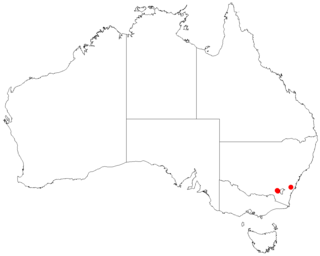
Prostanthera makinsonii is a species of flowering plant in the family Lamiaceae and is endemic to a restricted area of New South Wales. It is a spreading shrub with strongly aromatic, egg-shaped leaves and mostly glabrous purple flowers arranged in bunches of eight to twelve in upper leaf axils.

Prostanthera oleoides is a species of flowering plant that is endemic to central Queensland. It is an open, erect shrub with four-sided branchlets, narrow elliptic, oblong or egg-shaped leaves with the narrower end towards the base, and mauve flowers with purple to dark mauve markings.

Prostanthera petraea is a species of flowering plant in the family Lamiaceae and is endemic to a restricted area near the Queensland–New South Wales border. It is a large shrub to small tree with ridged, glandular branches, egg-shaped leaves and white flowers usually without markings.

Prostanthera sericea, commonly known as silky mintbush or walyuwalyu, is a species of flowering plant in the family Lamiaceae and is endemic to inland Australia. It is an erect shrub with hairy branches, cylindrical leaves and white flowers with mauve or purple streaks.
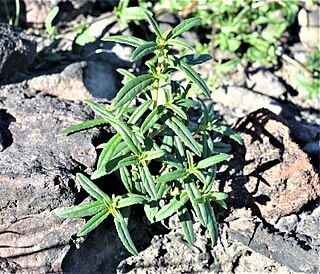
Prostanthera tallowa is a species of flowering plant in the family Lamiaceae and is endemic to the Kangaroo Valley area of New South Wales. It is an erect, aromatic shrub with narrow egg-shaped to linear leaves and mauve to light purple flowers with darker dots inside the petal tube.

Prostanthera tozerana is a species of flowering plant that is endemic to Mount Tozer in Queensland. It is a small, compact shrub with hairy branchlets, thick egg-shaped leaves with the narrower end towards the base, and pale purplish-mauve flowers.





















